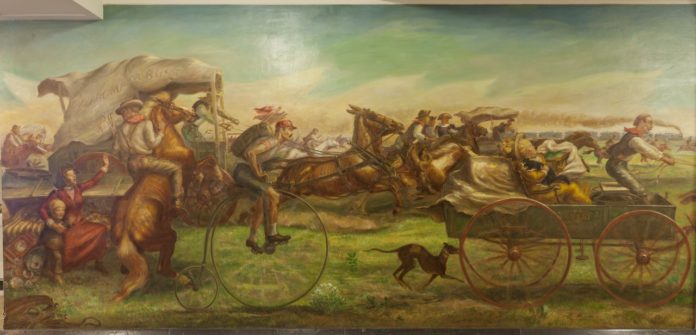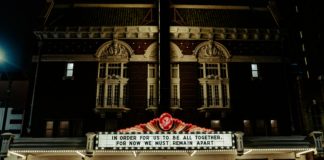
Mural: The Oklahoma Land Rush, April 22, 1889, by John Steuart Curry, courtesy of Department of Interior, Washington, D.C.
Homeownership is generally considered a staple of the American dream, symbolizing individual freedom, financial security, political representation, and access to community. Strongly rooted in our culture is the idea that a society of free land owners will create a society equitable for all. Yet somewhere along this Norman Rockwell image of our birthright, wealth — or ownership to be more precise — has become concentrated in the hands of a few and is not a reality for many Americans.
Today, amid the many equity gaps being revealed by the virus, homeownership in the U.S. stands at its lowest level in at least 20 years with minorities, young adults, and those in lower income tiers having a particularly low stake. This is because prime real estate is bought, developed, and owned by speculators investing from outside of a market looking to create and take profit away from communities. Powerful private equity groups fund real estate development through revenue generated by rental properties in cities like Austin.
For many millions of people, this creates a forced dependence on renting, stripping them of their freedom to build wealth while they generate profit for their landlords. Our search for shelter takes us to a vicious cycle of servitude. This trend was accelerated following the 2008 housing crash, after which speculators purchased homes in Austin, driving up prices, and coercing urban residents into renting rather than buying and owning homes.
Ownership is being undermined
Freedom of movement is a core part of the American Dream; we are a nation of immigrants, explorers, and frontiersmen. Or so we like to regard ourselves. While ownership may not seem necessary to the journey of life, it is key to the conclusion of the American Dream. That very dream of ownership is being undermined by the same system that created it. Ownership has long been integral to our society’s idea of power and wealth and it has been shaped by forces and decisions like the Homestead Act and Oklahoma Land Rush that must be considered deeply. Yet traditional home ownership has become outdated and encumbered with layers of agents, mortgage providers, title companies, utility setups, and associated costs at every turn. Substantial down payments are walls blocking ownership. Ownership is being written out of the journey with an unknown cost of an unsustainable conclusion.
Today, ownership structures in real estate are restricted to a mortgage-backed (or “death-pledge” backed – even the term is archaic) purchase of the title. Homeowners who move every five years never realize the equity benefits one traditionally anticipates from a mortgage due to the vesting nature of a mortgages combined with high transaction fees in real estate. Further, entering into a mortgage agreement financially locks the buyer into that property, slowing their ability to move to another neighborhood or state should the need arise.
Communities of owners are wealthier than communities of renters in part because owners’ monthly mortgage payments are equity investments in the land and property. Ownership also impacts access to credit on good terms. The current system values homeowners above renters, so homeowners with even a small fraction of ownership have access to more wealth than a renter. As home equity grows, they have access to even more credit and wealth. However, some aspects of renting – such as ease of moving and property management – are more desirable than traditional home ownership.
The new American Dream requires a clearer and more flexible path to ownership, free from discriminatory practices. The challenge is building a system that gives people the opportunity to build wealth through homeownership while continuing to offer freedom of mobility.
Enter Murphy, our imaginary exemplar
To illustrate the situation as it stands, consider a 22-year-old college graduate. Our graduate, we’ll call her Murphy, just landed her first position in sales, and is making an average of $45,000 a year. Congratulations!
Murphy hopes, in the near future, to find a job that pays her more. She decides to rent an apartment and keep the flexibility to move to another city should a new opportunity arise. Paying $1,100 a month for her rent and various utilities, she bankrolls her property management company a total of $26,400 over two years.
Murphy finds a better paying job in a larger metropolitan city and moves there, now earning $75,000 a year. But the cost of living is higher in this new city, and the apartment she finds that best suits her needs costs $1,200 a month. Not only that, it is located in a suburban area and requires a long commute to work. Murphy rents this apartment for only one year while she adjusts to life in the new city, finding a community, and eventually deciding to move to a more costly neighborhood.
The cost of living for Murphy in her new neighborhood is a little bit higher – she pays $1,500 a month for rent and utilities. After living there for a year, she meets Asena at a party and quickly falls for them. Within four months, they are dating, and within another year they decide to move in together, with Asena moving into Murphy’s house that she shares with two other roommates. This cuts their cost of living down to $750 each per month, since they share a room and split the rent equally.
After about two years of this co-living arrangement — and after Murphy gets a raise at work — they decide to get their own place. They find a well-priced house near a park in a residential neighborhood, far enough away from the city center to where they can afford the down payment, but not so far that they become isolated from their friends and social networks. They take out a mortgage on this house and spend the next fifteen to thirty years paying off their home.
Let’s pause a moment to carefully consider this. Murphy graduated college and began her first job at 22. Murphy spent over $100,000 on four different rental properties before finally taking a step into the exclusive homeowners’ club.
Why does this have to be the state of affairs? Could there be a different way?
What if residents of any property could build equity in their homes through the monthly payments that they make?
Enter Conara, turning renters into stewards
The Austin-based equity distribution management company we are developing, Conara, is working on a financial and legal model that will do exactly that. We, the authors, are investing in a future where every citizen has equity ownership through this benefit-corporation.
Set to launch in 2021 – Conara’s business model allows “stewards” to gain a percentage of ownership in the home that they make monthly payments on. Conara makes it clear that it petitions society to move away from using disempowering language like “rent”, “tenant”, and “landlord” which we believe carry negative and unhelpful connotations. As the property value goes up, and as more monthly payments are made, so does the valuation of the stewards’ stake in the home
When the stewards decide they want to move to another Conara property, that equity is transferred to the new home they move into. Alternatively, if the stewards decide they want to move to another non-Conara property, their vested equity stake can be liquidated into a cash payment instead.
It’s a solution that promotes maximum equity without debt.
Furthermore, Conara emboldens stewards to make improvements to their homes, increasing the value of their stake in the property. If Murphy had started her journey with Conara instead of a traditional apartment, she would have saved tens of thousands of dollars in the same amount of time. And she would financially benefit from improving her properties and communities the whole time.
The Future
Our reborn romance with urban life coincides with other advances in our technology and society. The density of cities enables better cross-pollination of ideas and creativity flows more readily. Industries and companies form and grow in cities. Scientist and author Paul Graham’s essay, Cities and Ambition, highlights the importance of cities as the driver toward technological progress and advancement. This is the process Conara encourages.
Housing costs in the urban areas of the United States have increased remarkably. Increased demand, ballooning costs of construction, and an exploding desire to live in urban areas have driven up costs.
The rising demand for housing in urban areas has not been met with adequate supply. Developers are producing new housing, but that housing by and large is produced for a return on capital rather than a return to the community.
As a result, here in Austin, the average home price has increased by more than 60 percent in the last decade.
Austin is well placed to set the example. It is up to us moving forward to ensure we build up our city in a way that is best suited to the living patterns we desire now and are trending toward.
We must build. And we must build homes that can be owned without debt.
In the future, as Conara and competing models emerge, monthly payments towards a house will begin to accrue equity ownership in the home. Acting much like a mortgage — yet more accessible and transferable across houses and condos around the country — the result would be easy mobility between homes at minimized transaction costs. Eventually, ownership without debt should be the default state for everyone. This is a future we can be proud of, the future our founders envisioned.
President, diplomat, and admirable husband John Adams observed that “the balance of power in a society accompanies the balance of property in land.” As such, he suggested, “The only possible way, then, of preserving the balance of power on the side of liberty and public virtue is to make the acquisition of land easy to every member of society…. If the multitude is possessed of the balance of real estate, the multitude will have the balance of power, and in that case the multitude will take care of the liberty, virtue, and interest of the multitude in all acts of government.”
The path is rocky. The entities that challenge the status quo will enter an ecosystem backed by powerful lobbying groups, deep pocketed banks, and first generation “sharing economy” rental companies. Our nation must balance the needs of the present with the needs of the future and give everyone a stake in building and maintaining a culture they desire.
Those who succeed in changing this system will define the future by offering a structure that eliminates barriers and benefits all Americans equally. They will allow people to move freely, find their communities, invest in those communities, and benefit from their flourishing.
This was and is again the American Dream, and indeed the dream that inspired the democractic revolution around the world. When a majority of people have positive personal net worth, and the individual debt crisis is managed, that dream will be fulfilled.
It is a big change. It will take decades. Home is where the heart is – and hearts do not change easily. But where better to begin the renewal than where we live?
Editor’s note: This article is co-authored by Andrew Escher, also a leader at Conara.
If you like what you’ve been reading, please click here to subscribe and we will send you updates and our newsletter.




